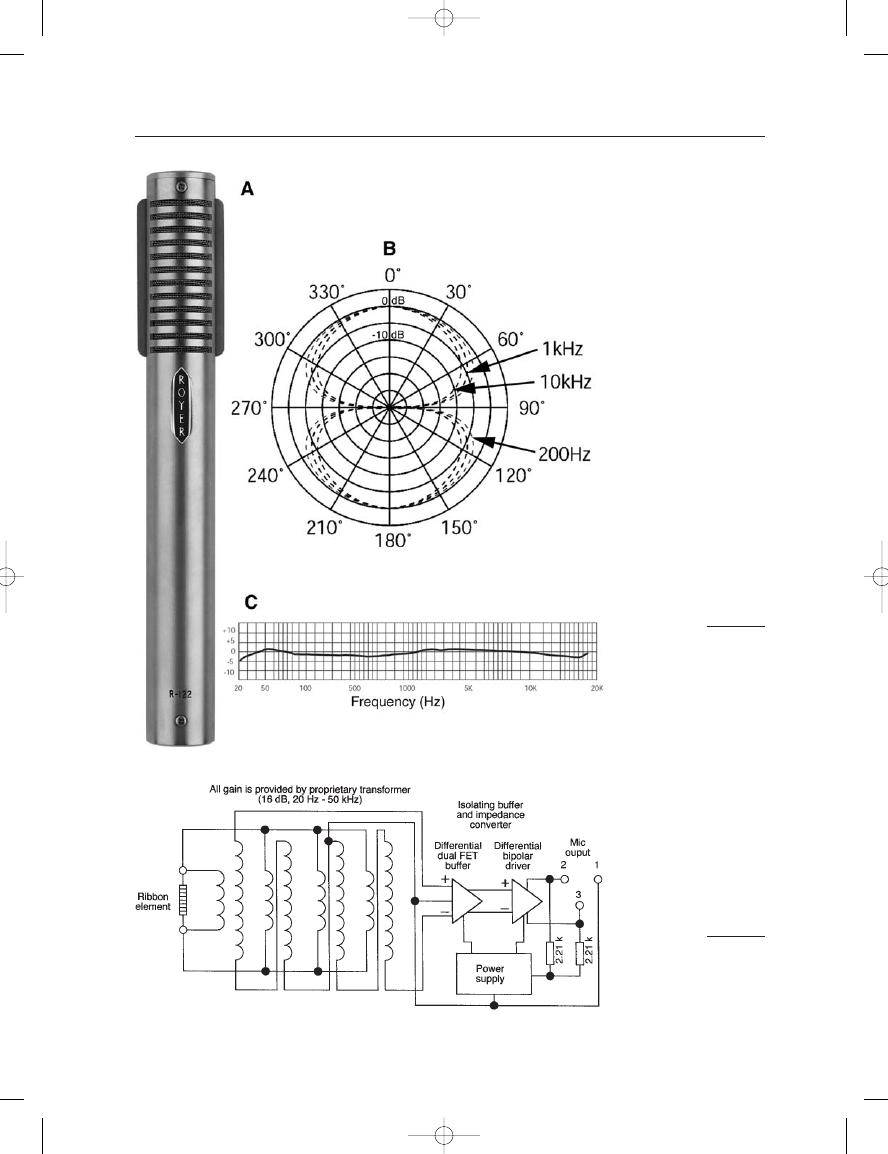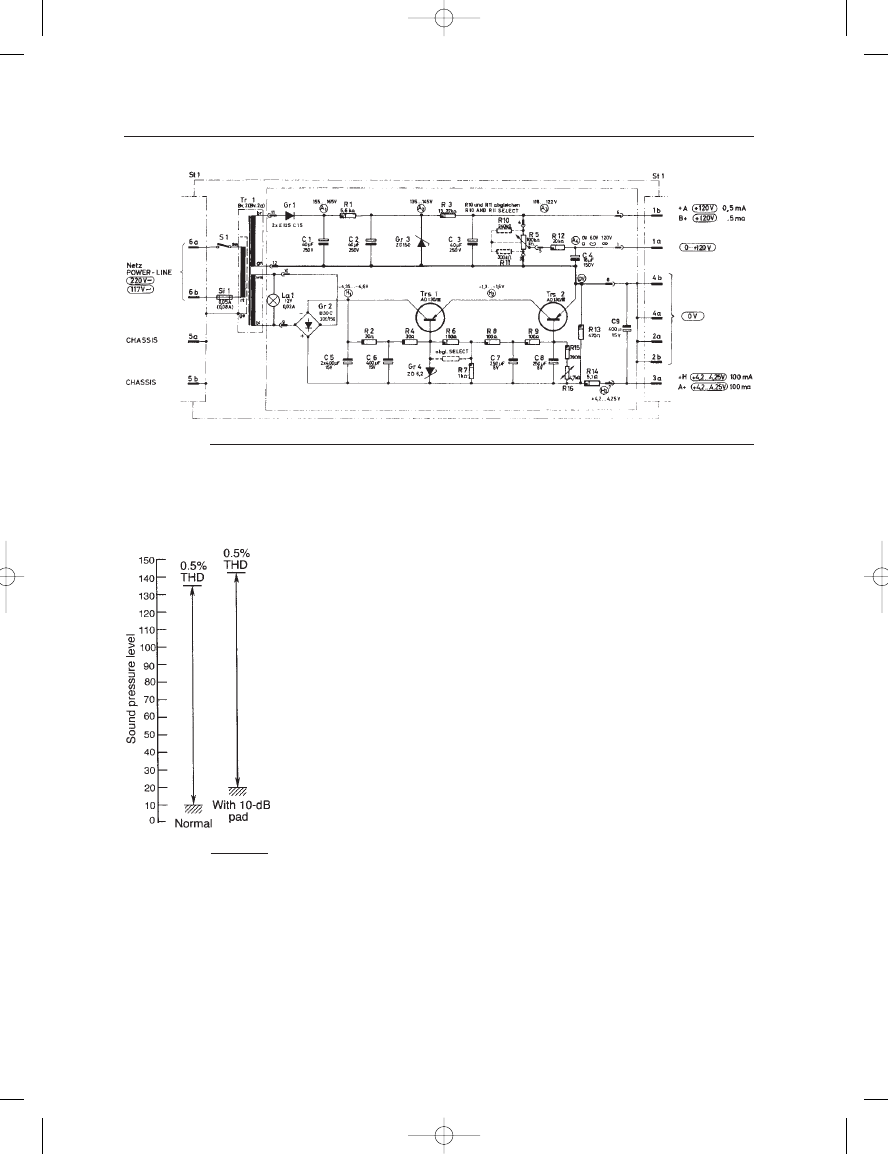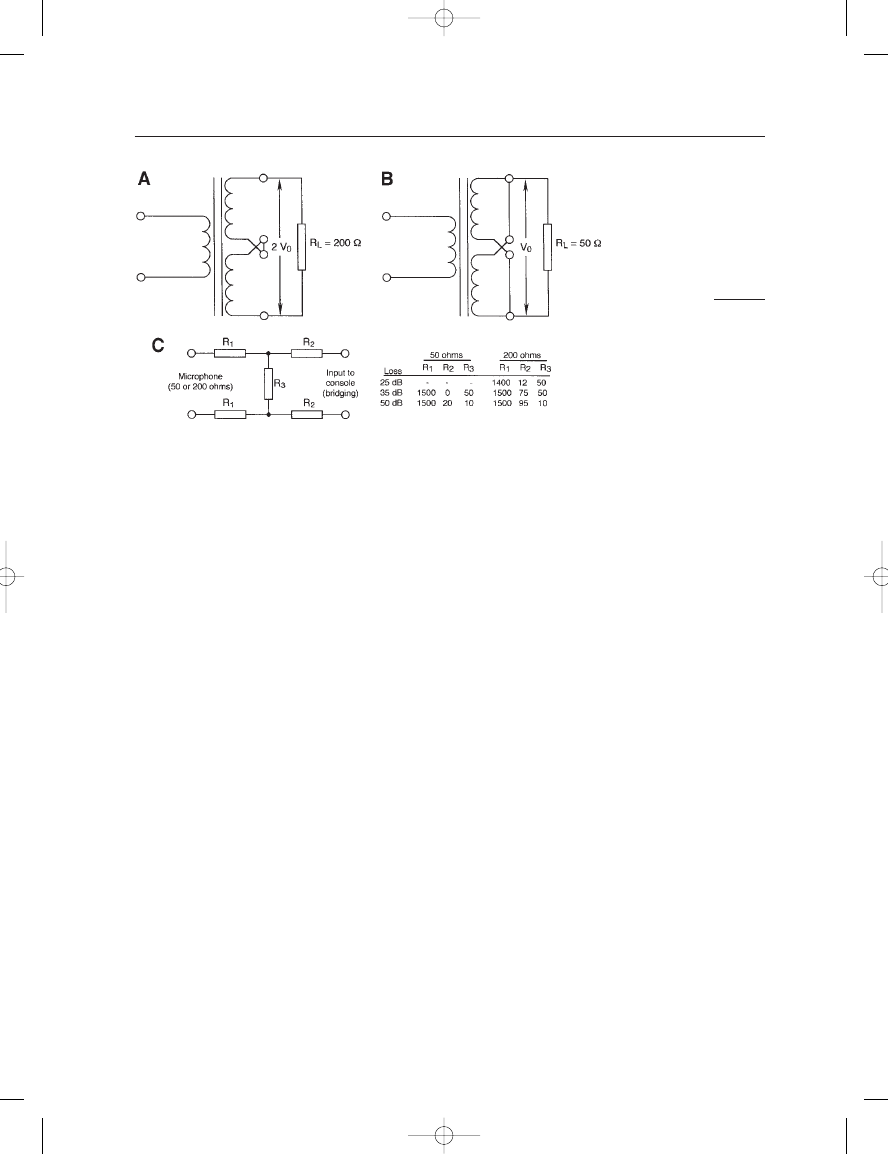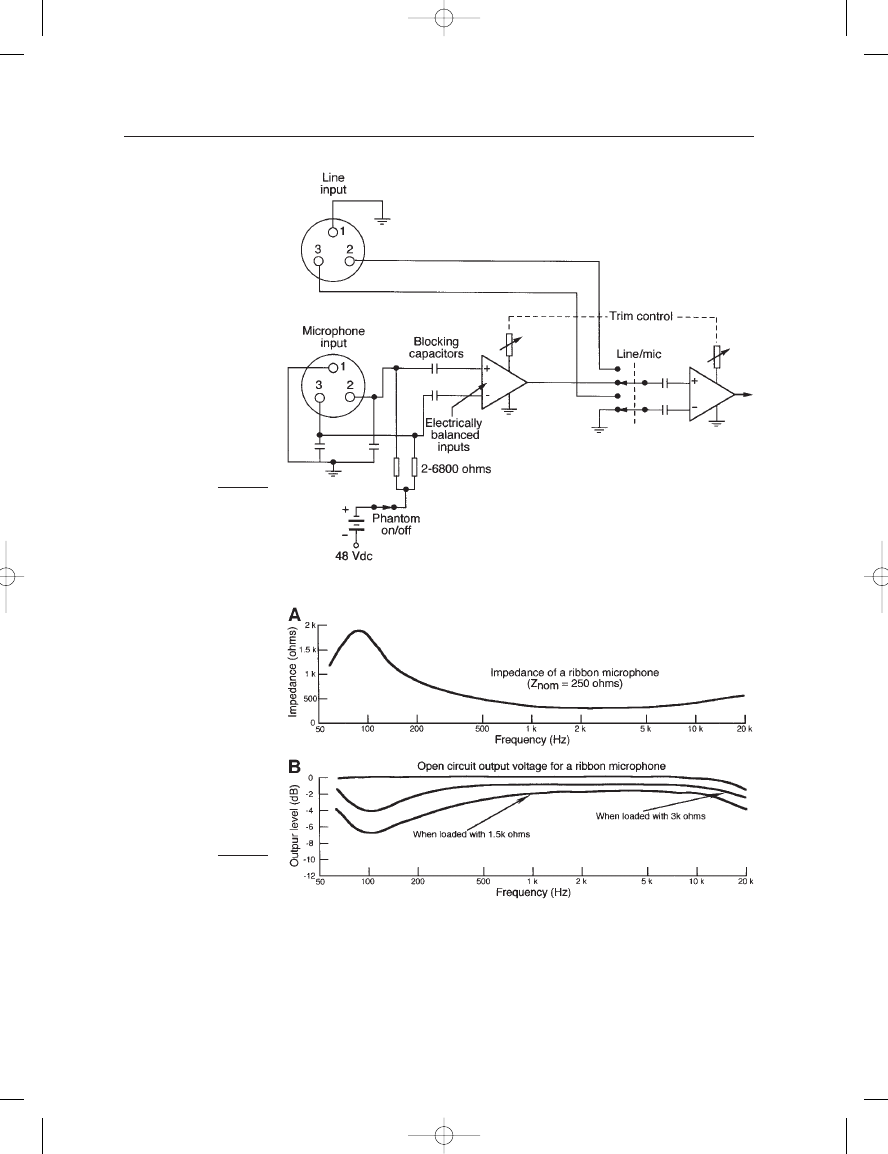ВУЗ: Казахская Национальная Академия Искусств им. Т. Жургенова
Категория: Книга
Дисциплина: Не указана
Добавлен: 03.02.2019
Просмотров: 17281
Скачиваний: 51

In an unusual design approach, Audio-Technica has introduced the
model AT3060 tube-type microphone which is powered at P48. A photo
of the microphone is shown in Figure 8–5A, and basic circuit details are
shown at B. Using a vacuum tube that will operate at a fairly low plate
potential of 37 Vdc, the tube filament requirement of 1.25 Vdc at a cur-
rent draw of 10 mA is attained via an unusual integrated circuit (IC)
arrangement shown in the bottom-right portion of Figure 8–5B. The
voltage at the input to the first IC is 10 V at a current of 1.25 mA. The
three ICs in tandem progressively halve the voltage, while doubling
the current, attaining a value of 1.25 V at a current draw of 10 mA at the
output of the final IC. Various diodes are used for maintaining separation
between signal and dc paths.
The microphone element itself is an electret. The AT3060 has a
nominal sensitivity of 25.1 mV/Pa and can handle levels in the studio of
134 dB. The self-noise floor of the microphone is 17 dB(A).
Royer Labs has introduced integral electronics for phantom power-
ing in two of their ribbon microphone models. Ribbons are particularly
susceptible to variations in downstream loading, and, with their relatively
low sensitivity, they may be subject to electrical interference in long runs.
Figure 8–6A shows a photo of the Royer Labs R-122, with performance
curves shown at B and C. The circuit diagram is shown in Figure 8–7.
The most unusual aspect of the circuit is the compound transformer,
which has four parallel sets of windings resulting in an optimum imped-
ance match to the ribbon. The secondaries of these four sections are con-
nected in series to attain a voltage gain of 16 dB, looking into the very
high input impedance of the buffer stage. The system has a maximum
level capability of 135 dB L
P
and a self noise no greater than 20 dB(A).
The sensitivity is 11 mV/Pa.
POWER SUPPLIES FOR OLDER TUBE MICROPHONES
Classic tube-type capacitor microphones are as popular today in studio
recording as they have ever been. In a typical power supply (one for each
microphone), dc voltages are produced for heating the vacuum tube’s
filament, biasing the capsule, and providing plate voltage for the vacuum
tube amplifier. In many dual diaphragm designs, remote pattern switch-
ing is also included in the supply. Such a design is shown in Figure 8–8.
Note that the cable connecting the power supply to the microphone
contains seven conductors.
MICROPHONE OUTPUT/CONSOLE PREAMP
INPUT CIRCUITRY
THE MICROPHONE OUTPUT PAD
Most capacitor microphones have an integral output pad, as described in
detail in Chapter 3, under Details of preamplifier and polarizing circuitry.
8: Electrical Considerations and Electronic Interface
123
Earg_08.qxd 14/9/04 2:45 PM Page 123

THE MICROPHONE BOOK
124
FIGURE 8–7
Circuit diagram for the
Royer Labs Model
R-122 microphone. (Figure
courtesy of Royer Labs.)
FIGURE 8–6
The Royer Labs Model
R-122 powered ribbon
microphone: photo
(A); polar response
(B); frequency response at
1 meter(C). (Data courtesy
of Royer Labs.)
Earg_08.qxd 14/9/04 2:45 PM Page 124

The effect of the pad is basically to shift the microphone’s entire operating
range from noise floor to overload point downward by some fixed
amount, normally 10 to 12 dB. The effect of this is shown in Figure 8–9.
Note that the total dynamic range of the microphone remains fixed, with
or without the pad.
THE MICROPHONE OUTPUT TRANSFORMER
A number of capacitor microphone models have an integral output
transformer built into the microphone body. Most early tube-type capac-
itor microphones had output transformers that were usually housed in
the power supply unit. The transformer often had split secondary wind-
ings and could be strapped for either parallel or series operation, as
shown in Figure 8–10. Typically, when the windings are strapped for
parallel operation (A), the output impedance is 50 ohms; for series strap-
ping (B) the output impedance is 200 ohms. In either case the output
power capability remains the same:
Output power
E
2
/R
V
2
/50
(2V)
2
/200.
In many cases it is necessary to reduce the output signal from the
microphone even lower than the parallel transformer strapping. H-pads
(shown in Figure 8–10 C) may be used both to maintain the impedance
relationship and produce the desired amount of attenuation. Today, most
transistorized capacitor microphones are transformerless and operate at
a fixed balanced output impedance.
8: Electrical Considerations and Electronic Interface
125
FIGURE 8–8
Power supply schematic for a tube capacitor microphone with variable pattern switching at the power supply; pin 1A
provides the pattern control voltage. (Figure courtesy of Neumann/USA).
FIGURE 8–9
Typical effect of
10 dB
microphone output pad on
maximum level capability
and self-noise of a
capacitor microphone.
Earg_08.qxd 14/9/04 2:45 PM Page 125

CONSOLE INPUT SECTION
In the very early days of broadcasting and recording, the dynamic micro-
phones of the period had relatively low outputs and normally operated
into matching input impedances. Typically, a microphone with a 600-
ohm source impedance looked into a 600-ohm load, following the
matched impedance concept. Impedance matching was a holdover from
early telephone practice and found its way into broadcasting, and from
there into recording. Today, the bridging concept is well established. In a
bridging system, all output impedances are relatively low and all input
impedances are relatively high throughout the audio chain. Here, the
ratio of high to low impedance is normally in the range of 10-to-1 or
greater.
Figure 8–11 shows a simplified transformerless console input section
showing switchable line-microphone operation. At one time transformers
were felt to be indispensable in the design of microphone input circuitry.
Their chief advantages are a high degree of electrical balance and conse-
quent high common-mode signal rejection. (A common-mode signal is
one that is identical at both inputs; typically, induced noise signals are
common mode.) In the era of vacuum tubes the input transformer was of
course essential. Today’s best solid state balanced input circuitry does not
mandate the use of transformers, and there are considerable economic
advantages to pass on to the user. Only under conditions of high electrical
interference might their use be required.
Today, most microphones have an output impedance in the range of
50 to 200 ohms. Most consoles have an input bridging impedance in the
range of 1500 to 3000 ohms.
IMPROPER MICROPHONE LOADING
A typical 250-ohm ribbon microphone may have an impedance modulus
as shown in Figure 8–12A. As long as the microphone looks into a high
THE MICROPHONE BOOK
126
FIGURE 8–10
Transformer strapping for
200 ohms (A) and 50 ohms
output impedance (B);
H-pad values for balanced
attenuation for microphone
impedances of 50 and 200
ohms (C).
Earg_08.qxd 14/9/04 2:45 PM Page 126

impedance load, its response will be fairly flat. When used with a modern
console having 1500- or 3000-ohm input impedances, the frequency
response will be altered as shown at B. This is a response problem routinely
encountered today and frequently goes unchallenged.
8: Electrical Considerations and Electronic Interface
127
FIGURE 8–11
Simplified circuit for a
transformerless console
microphone/line input
section.
FIGURE 8–12
Effect of loading on ribbon
microphone response.
Earg_08.qxd 14/9/04 2:45 PM Page 127